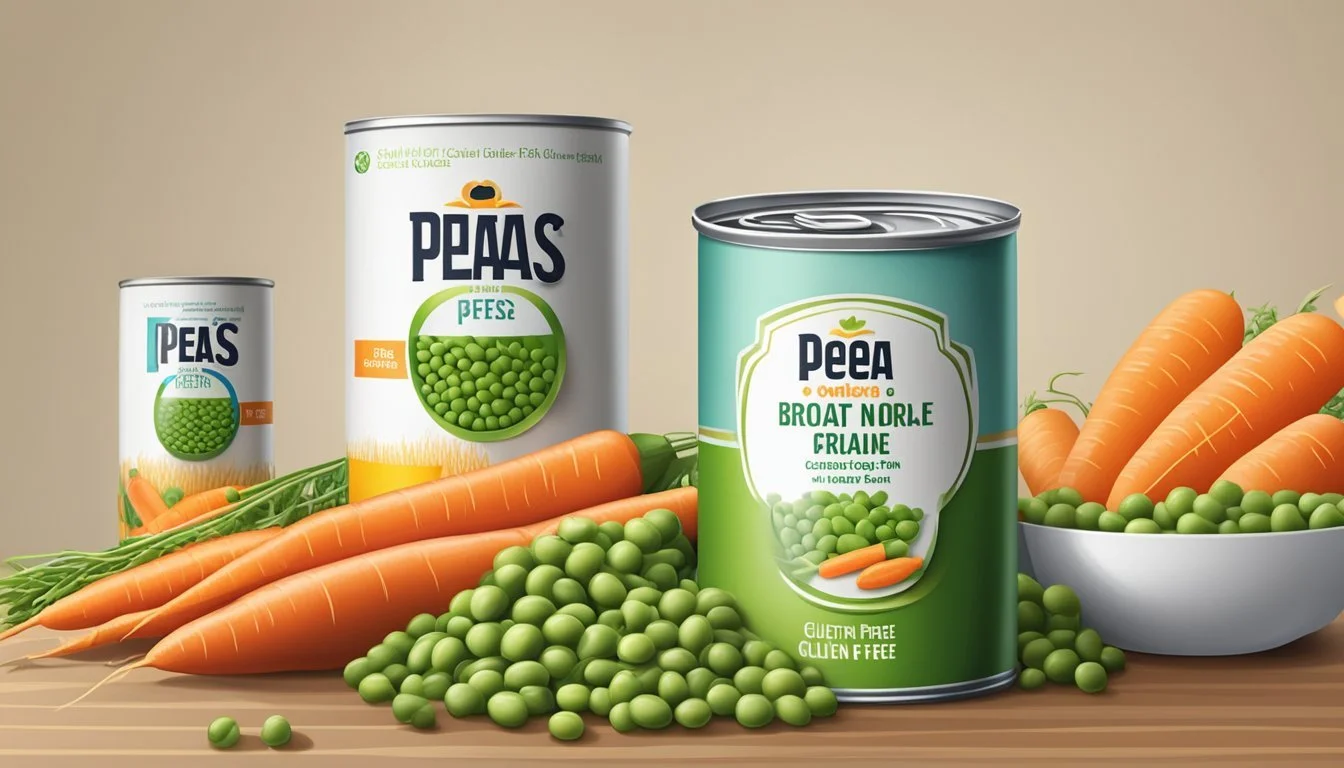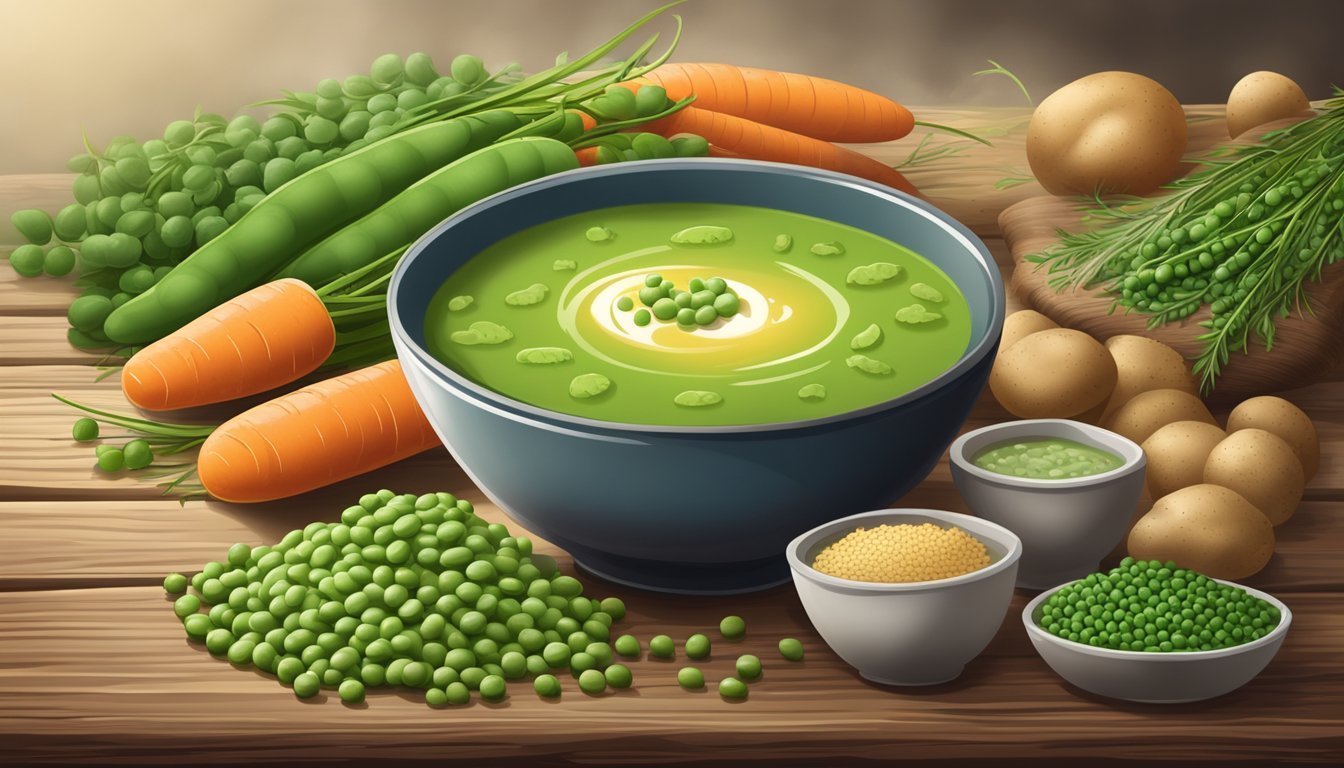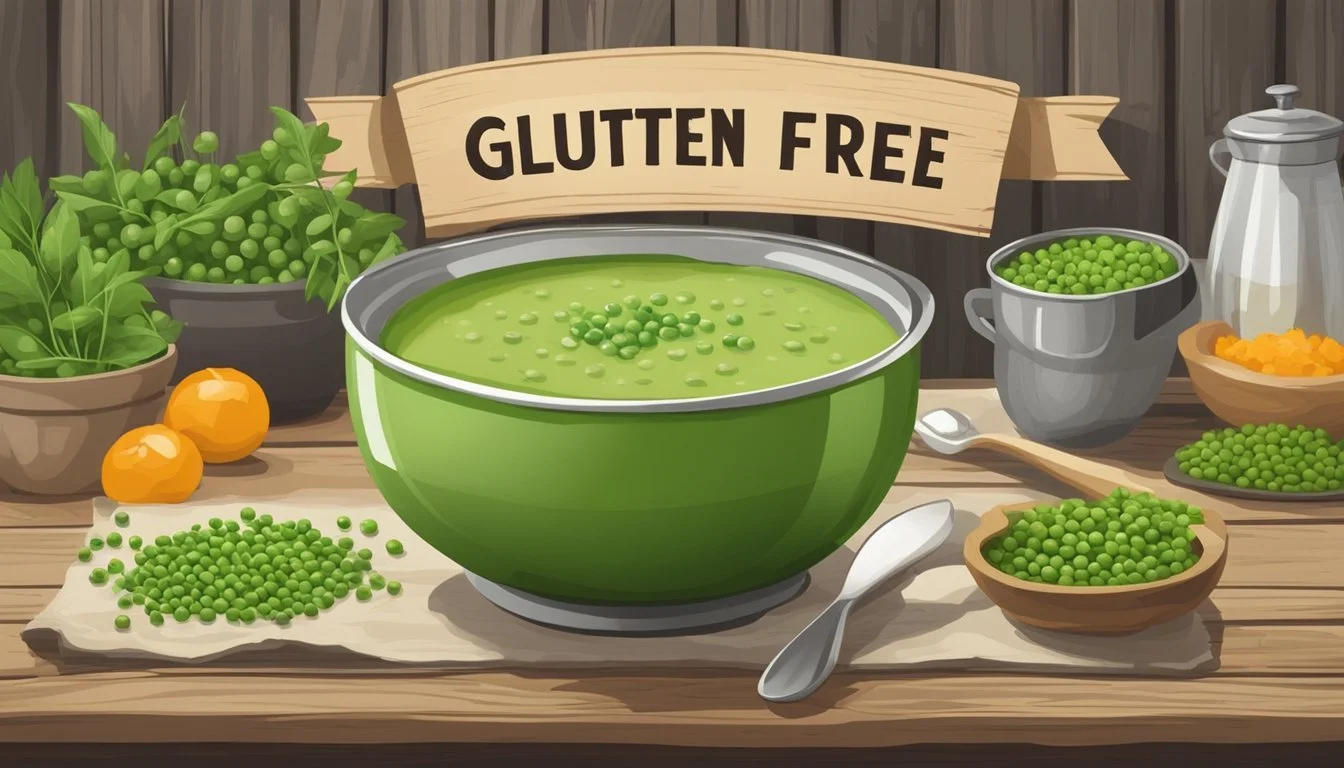Is Pea Soup Gluten-Free?
Unveiling the Truth About This Classic Dish
Pea soup is traditionally appreciated for its simplicity and comforting qualities. It is a dish made from split peas and may include various vegetables and, often, a ham hock or other pork elements for enriching flavor. Those with celiac disease or gluten intolerance face dietary challenges that necessitate careful consideration of ingredients in foods that many take for granted as being gluten-free. With the main ingredient being split peas, a legume that does not contain gluten, pea soup in its purest form is indeed gluten-free.
Yet, the gluten-free status of commercially prepared pea soups (What wine goes well with soups?) or restaurant offerings cannot be taken for granted. Gluten proteins are found in wheat, barley, rye, and crossbreeds of these grains, which means that any pea soup containing ingredients such as flour or barley—or even prepared in a facility that handles these gluten-containing grains—may not be safe for individuals avoiding gluten. Checking labels for certification or inquiring about preparation methods is crucial for those on a gluten-free diet.
Incorporating gluten-free pea soup into the diet offers a nutritious option that is often high in fiber and protein while being low in fat. Making pea soup at home allows for control over the ingredients and ensures the dish meets the dietary restrictions of those with gluten-related disorders. When carefully prepared with gluten-free ingredients, pea soup can be a hearty and healthy addition to the gluten-free table.
What Is Pea Soup?
Pea soup is a savory dish known for its thick texture and rich flavor, often considered a comfort food. It is typically made from split peas and can include various vegetables and sometimes a ham bone for depth of flavor.
History and Origins
Pea soup can trace its origins back centuries, with variations found across numerous cultures. The soup's base, split peas, has been a staple ingredient in many cuisines due to its affordability and storability. Over time, regions have adapted the recipe, incorporating local ingredients to create unique interpretations of this classic dish.
Basic Ingredients
The fundamental components of pea soup consist of:
Split peas: The primary ingredient that thickens the soup as it cooks.
Vegetables: Commonly onions, garlic, carrots, and celery contribute to the flavor profile.
Liquid: Broth or water is used to cook the split peas until tender.
Ham bone (optional): Often included in traditional recipes to infuse the soup with a smoky taste.
Pea soup is appreciated for its simplicity and its ability to be customized according to personal preferences or dietary needs, making it a versatile recipe for many households.
Gluten-Free Diet Basics
Implementing a gluten-free diet requires a fundamental understanding of gluten and its effects on health, especially for individuals with celiac disease or gluten intolerance.
Understanding Gluten
Gluten is a group of proteins found primarily in wheat, barley, and rye. It is responsible for the elastic texture of dough, allowing bread to rise during baking. A gluten-free diet excludes all products containing these grains and is critical for individuals with celiac disease or non-celiac gluten sensitivity. These dietary restrictions are necessary to prevent symptoms and long-term health complications associated with these conditions.
Gluten and Health
For those diagnosed with celiac disease, ingesting gluten triggers an immune response that damages the lining of the small intestine, which can lead to malabsorption of nutrients and a wide range of health issues. Gluten intolerance, while less severe, still causes discomfort, including gastrointestinal distress, headaches, and lethargy. Adhering to a gluten-free diet helps manage these symptoms and protects against further health risks. It's essential for these individuals to avoid cross-contamination and read labels carefully, as gluten can often be hidden in processed foods or shared cooking environments.
Examining Pea Soup Ingredients
When creating pea soup, the ingredients used can vary, but there are common components that form its base. A key consideration for gluten-free diets is the presence of gluten-containing ingredients, particularly in pre-made or processed soups.
Common Ingredients in Pea Soup
Pea soup traditionally consists of a combination of split peas and a flavorful mixture of vegetables and meat. The essential elements often include:
Split peas: The backbone of the soup, providing texture and protein.
Carrots: Add natural sweetness and color.
Celery: Provides a subtle, earthy flavor.
Onion and garlic: Foundation aromatics that enhance depth.
Broth or water: Either a meat-based broth or simply water is used as the liquid base. Chicken or vegetable broth is common.
Ham or bacon: Smoked meats (What wine goes well with smoked meats?) lend a rich, savory taste.
Herbs: Such as thyme, bay leaf, or parsley, contribute additional layers of flavor.
Salt and pepper: For seasoning.
These ingredients combine to create a hearty and nutritious dish.
Potential Sources of Gluten
While the base ingredients of pea soup are naturally gluten-free, caution must be taken, especially when not preparing the soup from scratch.
Broth: Some store-bought broths may contain additives with gluten.
Ham or bacon: Processed meats can have gluten-containing fillers.
Flour: Occasionally used as a thickener in soup recipes; gluten-free alternatives include cornstarch or potato starch.
It is critical for individuals with gluten sensitivities or celiac disease to meticulously inspect labels for hidden sources of gluten. When in doubt, opting for ingredients that are certified gluten-free can offer peace of mind.
Preparing Gluten-Free Pea Soup
When preparing gluten-free pea soup, it's essential to select suitable ingredients and employ cooking techniques that eliminate the risk of cross-contamination to ensure that the final product remains gluten-free, whether one chooses to cook in a pressure cooker, slow cooker, or on the stove.
Choosing Gluten-Free Ingredients
Split Peas: They are a staple in pea soup and are naturally gluten-free.
Broth: Always check the label for a gluten-free certification as some broths may contain additives with gluten.
Ham: If using, opt for a ham that is labeled gluten-free. Some processed meats might contain gluten as a filler or binder.
Vegetables: Typical vegetables like carrots, celery, onion, and potatoes are gluten-free.
Herbs and Spices: Ensure they are from a gluten-free source as some spice blends might be cross-contaminated with gluten.
Avoiding Cross-Contamination
Utensils and Cookware: Use cookware and utensils that have been thoroughly cleaned and designated for gluten-free cooking.
Surface Prep: Clean surfaces before preparing ingredients to avoid any gluten residue.
Storage: Store gluten-free ingredients separately from gluten-containing items.
Gluten-Free Cooking Techniques
Label Reading: Always read product labels carefully. Look for gluten-free certifications or indications that the product is free from gluten-containing ingredients.
Homemade vs. Store-Bought: When making homemade pea soup, control over ingredients ensures a gluten-free product. For store-bought options, always check the label.
Cooking Methods: Whether using a pressure cooker, slow cooker, or traditional stove for cooking pea soup, ensure that the appliance has not been previously used to cook gluten-containing foods, unless thoroughly cleaned.
Gluten-Free Pea Soup Variations
Pea soup can be tailored to meet gluten-free dietary requirements without compromising on taste or texture. Diverse ingredients can be used to create variations suitable for vegetarians and vegans, implement alternative thickeners, and introduce creative flavors.
Vegetarian and Vegan Options
To adapt pea soup for vegetarians and vegans, one can omit meat-based products such as the traditional ham bone. Instead, they might use a rich vegetable broth to infuse depth of flavor. Olive oil serves as an excellent base for sautéing aromatic vegetables like onions and celery, ensuring the soup maintains its savory qualities.
Alternative Gluten-Free Thickeners
Those needing a thicker consistency might typically reach for wheat flour, but there are several gluten-free alternatives that can achieve a similar result. Options include:
Rice Flour: A fine substitute that thickens without altering flavor.
Cornstarch: Provides a clear thickening, ideal for lighter soups.
Potato Starch: Adds a silky texture and is well-suited for soups that will be reheated.
When using these thickeners, one should mix them with a little cold water to form a slurry before adding to the hot soup to prevent clumping.
Creative Flavor Additions
Beyond the classic seasoning, gluten-free pea soup can be elevated with an array of herbs and spices for those seeking to add a twist:
Fresh Herbs: Such as thyme or rosemary, for a fragrant touch.
Garnishes: Including chopped parsley or green onions for a fresh flavor.
Experimenting with seasonings allows one to customize the soup to personal taste preferences while ensuring it remains gluten-free.
Sourcing Gluten-Free Ingredients
When preparing pea soup, one must ensure all ingredients are free from gluten. This means scrutinizing product labels and preferring items with gluten-free certification for peace of mind.
Reading Product Labels
Product labels serve as the first line of defense in identifying gluten-containing ingredients in store-bought products. One must look beyond the ingredient list, as gluten can be hidden in additives or flavorings. Ingredients such as wheat, barley, rye, or any derivatives of these grains should raise a red flag. Labels may also use terms like “natural flavors” or “modified food starch,” which necessitate further investigation to confirm their gluten status.
Gluten-Free Certification
Gluten-free certification offers an additional layer of assurance. Products bearing a gluten-free certification seal have been tested and meet strict standards for gluten content. One should prefer these products to reduce the risk of cross-contamination. When shopping, individuals should look for reputable certification programs that regularly test products to ensure they comply with gluten-free standards. Certification entities include:
The Gluten-Free Certification Organization (GFCO)
The Celiac Support Association (CSA)
By focusing on certified products, one reduces the chances of accidental gluten ingestion.
Gluten-Free Pea Soup Recipes
When preparing gluten-free pea soup, one can either opt for a homemade route utilizing fresh ingredients or select from various store-bought options that are certified gluten-free. For those with celiac disease or gluten sensitivity, ensuring that every component of the dish is free from gluten is crucial.
Homemade Recipes
She can make gluten-free pea soup at home by starting with dried peas that are naturally free from gluten. A basic recipe involves soaking peas, then simmering them with a variety of aromatic vegetables and herbs such as onions, celery, and thyme. Meat lovers often add a ham bone or diced ham for flavor depth, ensuring the ham used is gluten-free. Homemade stock is preferable, but if using store-bought, one should carefully read labels to ensure it's gluten-free. For a thicker soup without the gluten, individuals might use a gluten-free flour to make a roux, as mentioned in one of the recipes found in the search results. The roux can be browned in a skillet before adding it to the soup, lending both color and body without the use of traditional wheat flour.
Store-Bought Options
For those who prefer the convenience of pre-made meals, store-bought canned pea soup can be a time-saving option. However, buyers must vigilantly read labels as some brands may contain gluten. Gluten-free croutons or a slice of gluten-free bread can be the perfect accompaniments to a bowl of pea soup, enhancing the dining experience with added texture. To guarantee the integrity of a gluten-free diet, one should look for explicit 'gluten-free' labeling on any store-bought items.
Storing and Serving Gluten-Free Pea Soup
Storing gluten-free pea soup correctly extends its shelf life and preserves its flavor, while the right serving suggestions can enhance its taste and presentation.
Proper Storage Techniques
One can store gluten-free pea soup in a refrigerator or freezer. When refrigerating, pea soup should be placed in an airtight container and consumed within 3-4 days. For freezing, it's best to allow the soup to cool to room temperature before transferring it to freezer-safe containers or heavy-duty freezer bags. One should leave some space at the top as the soup will expand when frozen, and it can be kept for up to 6 months.
To thaw, the container can be moved to the refrigerator 24 hours before it's intended to be eaten, or it can be reheated directly from frozen over low heat in a saucepan, stirring occasionally.
Serving Suggestions
When serving gluten-free pea soup, one may add various garnishes and side dishes to complement the meal. Gluten-free croutons or a sprinkle of fresh parsley can add a pleasing crunch and a pop of color. A dollop of sour cream or yogurt can be added for a creamy texture, which should be gluten-free to maintain the dietary integrity of the dish. To serve, ladle the soup into bowls and apply the chosen garnishes right before serving to maintain their texture and freshness.
Health Benefits of Pea Soup
Pea soup offers several nutritional advantages, bringing together the wholesome benefits of legumes in a comforting bowl. It is high in protein and fiber, making it a substantial choice for those seeking a heartier soup option.
Nutritional Profile
Pea soup's nutritional profile is quite impressive, largely due to its main ingredient: peas. These legumes provide a variety of essential vitamins and minerals. A standard serving can offer a good amount of Vitamin A, Vitamin C, and Vitamin K.
Vitamin A contributes to maintaining healthy vision and supports the immune system.
Vitamin C is renowned for its immune-boosting properties.
Vitamin K is crucial for blood clotting and maintaining bone health.
Protein and Fiber Content
The protein content in pea soup comes primarily from split peas, which are a core component of the dish. As for fiber, a cup of pea soup can yield almost 5 grams.
Protein helps in the repair and growth of tissues and is an essential macronutrient for overall health.
Dietary Fiber not only has a laxative effect that can reduce constipation but also has been linked to blood sugar regulation and cholesterol management, which ultimately supports heart health.
By incorporating these nutrients into one's diet, pea soup can be both a satisfying and nutritionally beneficial meal.
Common Questions About Gluten-Free Pea Soup
When considering pea soup for a gluten-free diet, the distinction between traditional recipes and those tailored for celiac disease or gluten intolerance is crucial. It is important to understand the core ingredients and the potential for gluten cross-contamination to ensure a safe eating experience.
FAQs
Are dried split peas gluten-free? Dried split peas, which are a staple ingredient in pea soup, are naturally gluten-free. They are legumes, free from gluten-containing proteins found in wheat, barley, and rye.
Can pea soup be included in a gluten-free diet? Pea soup can be a suitable option for those with celiac disease or gluten intolerance, provided that all the ingredients used are gluten-free and there is no risk of cross-contamination.
What are the common variations of pea soup that might contain gluten? Pea soup variations that include additives like croutons, certain broths, or flavorings might contain gluten. It's imperative to check all ingredient labels when preparing or purchasing pea soup.
How can someone ensure a gluten-free version of pea soup? To guarantee a gluten-free version, one should use ingredients verified as gluten-free. This includes broth, spices, and any additional components like meat or vegetables.
Is pea soup offered in restaurants gluten-free? In restaurants, it is necessary to ask whether their pea soup is gluten-free, as kitchens may use ingredients or preparation surfaces that introduce the risk of gluten cross-contamination.










